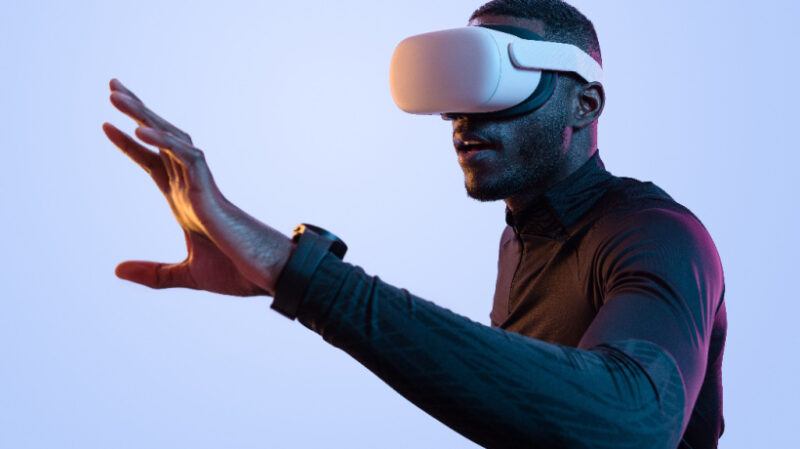
VR is changing the game with custom e-learning
With the growing demand for custom learning development, VR is becoming a powerful tool that enables organizations to simulate real-world scenarios and provide effective, lasting tailored training.
What is eLearning VR?
Virtual Reality is a simulated digital environment that immerses users in 3D spaces, allowing you to interact with content in a realistic way. When integrated into the creation of e-learning, VR realizes abstract concepts and turns passive learning into positive engagement. From healthcare to aviation, VR-based custom learning solutions are changing the way learners learn and retain information.
Realistic simulation: the core of immersive learning
One of the most influential applications of VR in creating eLearning is the development of realistic simulations. Instead of reading about surgical procedures, medical students can virtually do one. Training pilots can practice emergency protocols in a risk-free, simulated cockpit. These practical experiences mimic the complexity of real situations and improve learners’ confidence and performance.
This realism is especially valuable in custom learning development where content is tailored to the specific needs and challenges of an organization. VR allows developers to create unique simulations that perfectly match the enterprise procedures, compliance requirements, and learning goals.
Why VR is an e-learning game changer
Here are some reasons why VR is reshaping the future of e-learning solutions.
1. Higher engagement and retention
Traditional training methods often struggle to attract learners’ attention. VR, on the other hand, captivates users by placing them in an interactive environment. Research shows that immersive learning improves knowledge retention rates up to 80% over traditional learning methods.
2. A safe learning environment
VR allows learners to practice high-risk tasks such as performing surgery, managing hazardous materials, and troubleshooting machines, with the exception of actual results. These safe environments support trial and error, which are essential for mastering your skills.
3. Personalized learning path
Custom e-learning solutions developed in VR allow for an adaptive learning journey. Learners can make progress at their own pace, revisit scenarios, and tackle new challenges based on performance. This level of personalization is a hallmark of effective custom learning development.
4. Scalable and cost-effective
Initial investments in VR may seem high, but they can be more cost-effective in the long run. Once VR training modules are developed, they can be deployed in multiple locations, eliminating the need for live trainers, travel and materials. For global organizations, this scalability is invaluable.
AR and VR: The perfect pair of e-learning
VR offers a complete immersion, while Augmented Reality (AR) enhances the real world with digital overlays. It combines AR and VR to redefine how e-learning solutions are built and delivered. For example, maintenance technicians can use AR to display schematics overlaid on real equipment, while VR can be used in advance for full diagnostic simulations. This blended approach has gained the traction of custom e-learning development and provides a versatile strategy to provide context-on-demand learning.
Industry-wide practical applications
Below are some real-world examples of how organizations use VR to create e-learning.
health care
Virtual patients allow doctors and nurses to practice procedures, diagnosis, and patient interactions. Manufacturing
Employees train with assembly lines, equipment operation and safety procedures through simulated factories. retail
Staff learn customer service, product placement and sales tactics in a simulated store environment. Aviation and defense
Pilots and soldiers undergo mission-based simulations that replicate high stress scenarios.
These applications demonstrate the flexibility of VR in custom learning solutions, especially when content needs to match specific regulatory standards or operational goals.
Integration with other digital solutions
The synergy between VR and other digital tools such as e-book conversion is also worth noting. For example, interactive ebooks can serve as pre- or post-VR learning resources and provide theoretical knowledge that complements practical simulations. This multi-format approach supports a variety of learning styles and maximizes content retention.
Furthermore, the latest advancements in eLearning Creation Platforms make it easier to integrate VR content into a learning management system (LMS), track learner progress and collect performance analytics.
Conclusion
Integrating virtual reality into custom e-learning development is more than a trend. It’s a paradigm shift. By creating immersive, engaging, and personalized experiences, VR has proven to be a game changer in the world of e-learning solutions. Whether you’re enhancing training for high-risk jobs or creating engaging onboarding experiences, VR allows organizations to deliver impactful learning that drives real-world outcomes.
As technology continues to evolve, it is important for businesses looking to stay in a competitive landscape of e-learning creation, as they employ VR and its cousin AR. With the right strategies and development partners, VR can change the way you learn, perform and grow your workforce.
Impelsys
Impelsys is a leading provider of learner-centric digital courseware solutions and comprehensive end-to-end learning management platforms. We bring over 20 years of experience in developing interactive, personalized and engaging custom e-learning courses.


